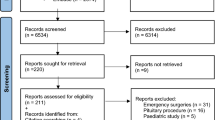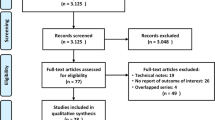Abstract
Background
Meningitis occurs in 0.8–1.5% of patients undergoing neurosurgery. The aim of the study was to evaluate the characteristics of meningitis after endoscopic endonasal transsphenoidal surgery (EETS) comparing the findings retrieved to those highlighted by literature search.
Materials and methods
Patients treated by EETS during an 18-year period in the Department of Neurosurgery of ‘Federico II’ University of Naples were evaluated and included in the study if they fulfilled criteria for meningitis. Epidemiological, demographic, laboratory, and microbiological findings were evaluated. A literature research according to PRISMA methodology completed the study.
Results
EETS was performed on 1450 patients, 8 of them (0.6%) had meningitis [median age 46 years (range 33–73)]. Endoscopic surgery was performed 1–15 days (median 4 days) before diagnosis. Meningeal signs were always present. CSF examination revealed elevated cells [median 501 cells/μL (range 30–5728)], high protein [median 445 mg/dL (range 230–1210)], and low glucose [median 10 mg/dL (range 1–39)]. CSF culture revealed Gram-negative bacteria in four cases (Klebsiella pneumoniae, Escherichia coli, Alcaligenes spp., and Haemophilus influenzae), Streptococcus pneumoniae in two cases, Aspergillus fumigatus in one case. An abscess occupying the surgical site was observed in two cases. Six cases reported a favorable outcome; two died. Incidence of meningitis approached to 2%, as assessed by the literature search.
Conclusions
Incidence of meningitis after EETS is low despite endoscope goes through non-sterile structures; microorganisms retrieved are those present within sinus microenvironment. Meningitis must be suspected in patients with persistent fever and impaired conscience status after EETS.
Similar content being viewed by others
References
McIntyre PB, O’Brien KL, Greenwood B, van de Beek D. Effect of vaccines on bacterial meningitis worldwide. Lancet. 2012;380:1703–11. doi:10.1016/S0140-6736(12)61187-8.
Castelblanco RL, Lee M, Hasbun R. Epidemiology of bacterial meningitis in the USA from 1997 to 2010: a population-based observational study. Lancet Infect Dis. 2014;14:813–9. doi:10.1016/S1473-3099(14)70805-9.
McClelland S 3rd, Hall WA. Postoperative central nervous system infection: incidence and associated factors in 2111 neurosurgical procedures. Clin Infect Dis. 2007;45:55–9. doi:10.1086/518580.
Pellegrino P, Carnovale C, Perrone V, Salvati D, Gentile M, Brusadelli T, et al. Epidemiological analysis on two decades of hospitalisations for meningitis in the United States. Eur J Clin Microbiol Infect Dis. 2014;33:1519–24. doi:10.1007/s10096-014-2102-2.
van de Beek D, Drake JM, Tunkel AR. Nosocomial bacterial meningitis. N Engl J Med. 2010;362:146–54. doi:10.1056/NEJMra0804573.
Chochua S, D’Acremont V, Hanke C, Alfa D, Shak J, Kilowoko M, et al. Increased nasopharyngeal density and concurrent carriage of Streptococcus pneumoniae, Haemophilus influenzae, and Moraxella catarrhalis are associated with pneumonia in febrile children. PLoS One. 2016;11:e0167725. doi:10.1371/journal.pone.0167725.
Revai K, Mamidi D, Chonmaitree T. Association of nasopharyngeal bacterial colonization during upper respiratory tract infection and the development of acute otitis media. Clin Infect Dis. 2008;46:e34–7. doi:10.1086/525856.
Wolter N, Tempia S, Cohen C, Madhi SA, Venter M, Moyes J, et al. High nasopharyngeal pneumococcal density, increased by viral coinfection, is associated with invasive pneumococcal pneumonia. J Infect Dis. 2014;210:1649–57. doi:10.1093/infdis/jiu326.
Cappabianca P, Cavallo LM, de Divitiis E. Endoscopic endonasal transsphenoidal surgery. Neurosurgery. 2004;55:933–40.
de Divitiis E, Cappabianca P, Cavallo LM. Endoscopic transsphenoidal approach: adaptability of the procedure to different sellar lesions. Neurosurgery. 2002;51:699–705.
Cappabianca P, Cavallo LM, Esposito F, de Divitiis O, Messina A, de Divitiis E. Extended endoscopic endonasal approach to the midline skull base: the evolving role of transsphenoidal surgery. In: Pickard JD, Akalan N, Di Rocco C, Dolenc VV, Lobo Antunes J, Mooij JJA, Schramm J, Sindou M, editors. Advances and technical standards in neurosurgery. Wien New York: Springer; 2008. p. 152–99.
Catapano G, de Notaris M, Di Maria D, Fernandez LA, Di Nuzzo G, Seneca V, et al. The use of a three-dimensional endoscope for different skull base tumors: results of a preliminary extended endonasal surgical series. Acta Neurochir. 2016;158:1605–16. doi:10.1007/s00701-016-2847-8.
Halvorsen H, Ramm-Pettersen J, Josefsen R, Rønning P, Reinlie S, Meling T, et al. Surgical complications after transsphenoidal microscopic and endoscopic surgery for pituitary adenoma: a consecutive series of 506 procedures. Acta Neurochir. 2014;156:441–9. doi:10.1007/s00701-013-1959-7.
Guvenc G, Kizmazoglu C, Pinar E, Abdülkadir I, Kaya I, Bezircioglu H, et al. Outcomes and complications of endoscopic versus microscopic transsphenoidal surgery in pituitary adenoma. J Craniofac Surg. 2016;27:1015–20. doi:10.1097/SCS.0000000000002684.
Somma T, Maraolo AE, Esposito F, Cavallo LM, Tosone G, Orlando R, et al. Efficacy of ultra-short single agent regimen antibiotic chemo-prophylaxis in reducing the risk of meningitis in patients undergoing endoscopic endonasal transsphenoidal surgery. Clin Neurol Neurosurg. 2015;139:206–9. doi:10.1016/j.clineuro.2015.10.007.
Cavallo LM, Messina A, Cappabianca P, Esposito F, de Divitiis E, Gardner P, Tschabitscher M. Endoscopic endonasal surgery of the midline skull base: anatomical study and clinical considerations. Neurosurg Focus. 2005;19:E2.
Shamseer L, Moher D, Clarke M, Ghersi D, Liberati A, Petticrew M, et al. Preferred reporting items for systematic review and meta-analysis protocols (PRISMA-P) 2015: elaboration and explanation. BMJ. 2015;349:g7647. doi:10.1136/bmj.i4086.
Tian R, Hao S, Hou Z, Gao Z, Liu B. The characteristics of post-neurosurgical bacterial meningitis in elective neurosurgery in 2012: a single institute study. Clin Neurol Neurosurg. 2015;139:41–5. doi:10.1016/j.clineuro.2015.09.002.
Korinek AM, Baugnon T, Golmard JL, van Effenterre R, Coriat P, Puybasset L. Risk factors for adult nosocomial meningitis after craniotomy: role of antibiotic prophylaxis. Neurosurgery. 2006;59:126–33. doi:10.1227/01.neu.0000243291.61566.21.
Korinek AM, Golmard JL, Elcheick A, Bismuth R, van Effenterre R, Coriat P, Puybasset L. Risk factors for neurosurgical site infections after craniotomy: a critical reappraisal of antibiotic prophylaxis on 4578 patients. Br J Neurosurg. 2005;19:155–62. doi:10.1080/02688690500145639.
Wang KW, Chang WN, Huang CR, Tsai NW, Tsui HW, Wang HC, Su TM, Rau CS, Cheng BC, Chang CS, Chuang YC, Liliang PC, Tsai YD, Lu CH. Post-neurosurgical nosocomial bacterial meningitis in adults: microbiology, clinical features, and outcomes. J Clin Neurosci. 2005;12:647–50. doi:10.1016/j.jocn.2004.09.017.
van de Beek D, Cabellos C, Dzupova O, Esposito S, Klein M, Kloek AT, ESCMID, et al. Study Group for Infections of the Brain (ESGIB). ESCMID guideline: diagnosis and treatment of acute bacterial meningitis. Clin Microbiol Infect. 2016;22:S37–62. doi:10.1016/j.cmi.2016.01.007.
Zarrouk V, Vassor I, Bert F, Bouccara D, Kalamarides M, Bendersky N, et al. Evaluation of the management of postoperative aseptic meningitis. Clin Infect Dis. 2007;44:1555–9.
Somma T, Solari D, Beer-Furlan A, Guida L, Otto B, Prevedello D, et al. Endoscopic endonasal management of rare sellar lesions: clinical and surgical experience on 78 cases and review of the literature. World Neurosurg. 2017;100:369–80. doi:10.1016/j.wneu.2016.11.057.
Chong MY, Quak SM, Chong CT. Cerebral ischaemia in pituitary disorders—more common than previously thought: two case reports and literature review. Pituitary. 2014;17:171–9. doi:10.1007/s11102-013-0485-1.
Sylvester PT, Moran CJ, Derdeyn CP, Cross DT, Dacey RG, Zipfel GJ, et al. Endovascular management of internal carotid artery injuries secondary to endonasal surgery: case series and review of the literature. J Neurosurg. 2016;125:1256–76. doi:10.3171/2015.6.JNS142483.
Takeuchi K, Watanabe T, Nagatani T, Nagata Y, Chu J, Wakabayashi T. Incidence and risk factors of subdural hematoma after intraoperative cerebrospinal fluid leakage during the transsphenoidal approach. Pituitary. 2016;19:565–72. doi:10.1007/s11102-016-0746-x.
Amano K, Hori T, Kawamata T, Okada Y. Repair and prevention of cerebrospinal fluid leakage in transsphenoidal surgery: a sphenoid sinus mucosa technique. Neurosurg Rev. 2016;39:123–31. doi:10.1007/s10143-015-0667-6.
Bhatki AM, Pant H, Snyderman CH, Carrau RL, Kassam AB, Prevedello DM, et al. Reconstruction of the cranial base after endonasal skull base surgery: local tissue flaps. Oper Techn Otolaryngol. 2010;21:74–82. doi:10.1016/j.otot.2009.10.003.
Beer R, Pfausler B, Schmutzhard E. Infectious intracranial complications in the neuro-ICU patient population. Curr Opin Crit Care. 2010;16:117–22. doi:10.1097/MCC.0b013e328338cb5f.
Ivan ME, Iorgulescu JB, El-Sayed I, McDervott MW, Parsa AT, Pletcher SD, et al. Risk factors for postoperative cerebrospinal fluid leak and meningitis after expanded endoscopic endonasal surgery. J Clin Neurosci. 2015;22:48–54. doi:10.1016/j.jocn.2014.08.009.
Schenck LP, Surette MG, Bowdish DME. Composition and immunological significance of the upper respiratory tract microbiota. FEBS Lett. 2016;590:3705–20. doi:10.1002/1873-3468.12455.
Vickery TW, Ramakrishnan VR. Bacterial Pathogens and the Microbiome. Otolaryngol Clin North Am. 2017;50:29–47. doi:10.1016/j.otc.2016.08.004.
Pagliano P, Ascione T, Boccia G, De Caro F, Esposito S. Listeria monocytogenes meningitis in the elderly: epidemiological, clinical and therapeutic findings. Infez Med. 2016;24:105–11 PMID: 27367319.
Pagliano P, Attanasio V, Rossi M, Ascione T, Fraganza F, Di Sarno R, et al. Pneumococcal meningitis in cirrhotics: distinctive findings of presentation and outcome. J Infect. 2012;65:577–9. doi:10.1016/j.jinf.2012.08.019.
Pagliano P, Attanasio V, Rossi M, Carleo MA, Carannante N, Ascione T, et al. Listeria monocytogenes meningitis in the elderly: distinctive characteristics of the clinical and laboratory presentation. J Infect. 2015;71:134–6. doi:10.1016/j.jinf.2015.02.003.
Author information
Authors and Affiliations
Corresponding author
Ethics declarations
Conflict of interest
None.
Ethical approval
Internal review board judged the project of the study and the final title of the paper compliant with ethical standards.
Informed consent
Each patient signed an informed consent before surgical procedure and when he was admitted to the Unit of Infectious Diseases.
Funding
No funding was received for this study.
Transparency declarations
None to declare.
Electronic supplementary material
Below is the link to the electronic supplementary material.
Rights and permissions
About this article
Cite this article
Pagliano, P., Caggiano, C., Ascione, T. et al. Characteristics of meningitis following transsphenoidal endoscopic surgery: a case series and a systematic literature review. Infection 45, 841–848 (2017). https://doi.org/10.1007/s15010-017-1056-6
Received:
Accepted:
Published:
Issue Date:
DOI: https://doi.org/10.1007/s15010-017-1056-6




